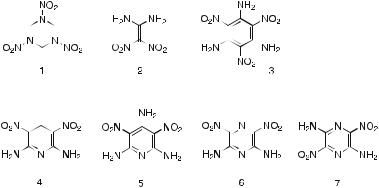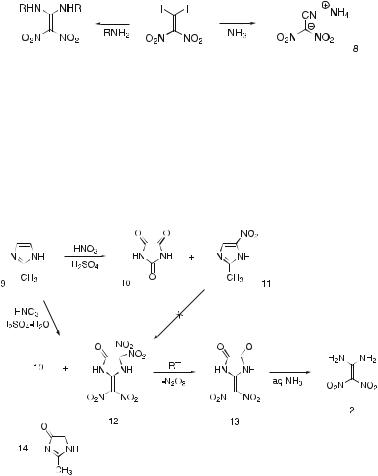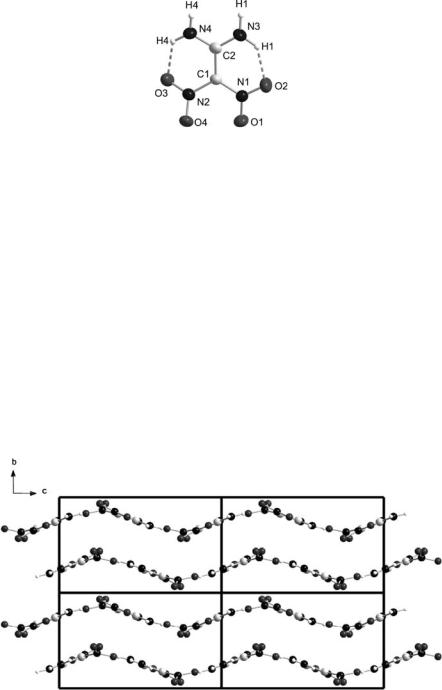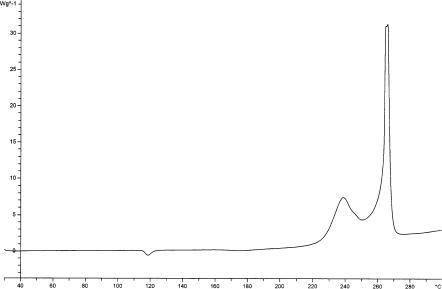
FOX-7 Bellamy
.pdf
Struct Bond (2007) 125: 1–33 DOI 10.1007/430_2006_054
♥ Springer-Verlag Berlin Heidelberg Published online: 25 January 2007
FOX-7 (1,1-Diamino-2,2-dinitroethene)
Anthony J. Bellamy
Cranfield University, Defence Academy of the United Kingdom, Shrivenham, Swindon SN6 8LA, UK
a.j.bellamy@cranfield.ac.uk
1 |
Introduction . . . . . . . . . . . . . . . . . . . . . . . . . . . . . . . . . . . |
1 |
2 |
Historical Development . . . . . . . . . . . . . . . . . . . . . . . . . . . . . |
3 |
3 |
Structural Properties of FOX-7 . . . . . . . . . . . . . . . . . . . . . . . . . |
5 |
4 |
Thermal Decomposition of FOX-7 . . . . . . . . . . . . . . . . . . . . . . . |
9 |
5 |
Spectroscopic Properties of FOX-7 . . . . . . . . . . . . . . . . . . . . . . . |
11 |
6 |
Explosive Properties of FOX-7 . . . . . . . . . . . . . . . . . . . . . . . . . |
13 |
7 |
Chemical Reactions of FOX-7 . . . . . . . . . . . . . . . . . . . . . . . . . |
16 |
8 |
Alternative Attempts to Synthesize FOX-7 . . . . . . . . . . . . . . . . . . |
22 |
9 |
Isomers of FOX-7 . . . . . . . . . . . . . . . . . . . . . . . . . . . . . . . . |
24 |
10 |
Compounds Structurally Related to FOX-7 . . . . . . . . . . . . . . . . . . |
28 |
References . . . . . . . . . . . . . . . . . . . . . . . . . . . . . . . . . . . . . . . |
31 |
|
Abstract In this paper, the discovery and synthesis of the explosive 1,1-diamino-2,2- dinitroethene (FOX-7) are described, together with an account of its structural, spectroscopic, and explosive properties. The chemical reactivity of FOX-7 towards nucleophilic substitution (transamination), electrophilic substitution, and acid-base properties is explored, as is its thermal behavior (phase transformations and thermal decomposition). The molecular structure and physical properties of FOX-7 are compared with those of its three isomers (as yet unsynthesized), as derived by theoretical calculations. Finally, the physical properties of FOX-7 are compared to those of various energetic molecules that are structurally related to FOX-7.
Keywords 1,1-Diamino-2,2-dinitroethene · FOX-7 · Synthesis · Properties · Reactions · Isomers · Related molecules
1 Introduction
For more than half a century, the main explosive component of artillery shells and other explosive devices has been RDX (1,3,5-trinitro-1,3,5-

2 |
A.J. Bellamy |
triazacyclohexane, 1). While RDX was not the most energetic material available during most of this period, it was relatively easy to produce, in a single step, from commonly available reagents, namely hexamethylenetetramine (hexamine), nitric acid, and, in most processes, acetic anhydride. However, RDX exhibits several unsatisfactory properties when used as a high explosive. It is sensitive to impact, friction, electrostatic discharge and heat, and it is this sensitivity that has been the cause of many very serious accidents where ordnance has either suffered direct impact by enemy fire or been subjected to heating in fires. Consequently, during the past 25 years there has been a search for replacement explosive materials that are at least as energetic as RDX but at the same time are much less sensitive to external stimuli. One such potential replacement is the simple molecule 1,1-diamino- 2,2-dinitroethene, also known as FOX-7 (2).
1,1-Diamino-2,2-dinitroethene is structurally similar to several other known energetic molecules. For example, 1,3,5-triamino-2,4,6-trinitroben- zene (TATB, 3) possesses a similar juxtaposition of amino and nitro groups, as do 2,6-diamino-3,5-dinitropyridine (DADNP, 4), 2,4,6-triamino- 3,5-dinitropyridine (TADNP, 5), 2,6-diamino-3,5-dinitropyrazine (6) and 2,5-diamino-3,6-dinitropyrazine (7). TATB in particular is known to be extremely insensitive to external stimuli. These relatives of 1,1-diamino-2,2- dinitroethene are however not easily manufactured and involve multi-step processes. What makes 1,1-diamino-2,2-dinitroethene particularly attractive as a replacement for RDX is the relative ease with which it can be synthesized in what is basically a single-step process.
Although 1,1-diamino-2,2-dinitroethene appears to have been originally isolated by Russian workers, its first reported synthesis in the scientific literature was by workers at the Swedish Defence Research Agency (FOI, formerly FOA). Indeed, the name FOX-7 derives from the acronym FOA, with X corresponding to explosive, as in RDX, etc.

FOX-7 (1,1-Diamino-2,2-dinitroethene) |
3 |
2
Historical Development
An initial attempt to synthesize 1,1-diamino-2,2-dinitroethene was made by Baum et al. [1] during their study of the reaction of 1,1-diiodo-2,2- dinitroethene with various amines. Many amines were found to react to give replacement of both iodine atoms by amine functions, the final product being the corresponding 1,1-bis(alkylamino)-2,2-dinitroethene (Scheme 1). It was therefore logical to expect ammonia itself would react in the same manner to give 1,1-diamino-2,2-dinitroethene. However, the product from treatment of 1,1-diiodo-2,2-dinitroethene with ammonia was not 1,1-diamino-2,2- dinitroethene, but the ammonium salt of cyanodinitromethane (8).
Scheme 1 Reactions of 1,1-di-iodo-2,2-dinitroethene
The first successful synthesis of 1,1-diamino-2,2-dinitroethene was reported in 1998 [2] by the group from FOI. It was initially isolated in low yield after hydrolysis of the product mixture obtained from the mixed acid (nitric and sulphuric acid) nitration of 2-methylimidazole (9). The choice of reaction conditions is rather critical. Nitration with nitric acid in 101– 105% sulphuric acid gave a mixture of parabanic acid (10) and 2-methyl-4-
Scheme 2 Nitration of 2-methylimidazole (9)

4 |
A.J. Bellamy |
nitroimidazole (11), but when 80–100% sulphuric acid was used, the products were parabanic acid and 2-dinitromethylene-4,4-dinitroimidazolidin- 5-one (12). The latter separated from the reaction medium and was filtered off. It was found to be thermally unstable and lost the elements of N2O3 to form 2-dinitromethyleneimidazolidine-4,5-dione (13). The dione was subsequently hydrolyzed with aqueous ammonia to give 1,1-diamino- 2,2-dinitroethene and oxalate (Scheme 2). A number of control experiments showed that 2-methyl-4-nitroimidazole was not an intermediate in the formation of 2-dinitromethylene-4,4-dinitroimidazolidin-5-one, but that 2-methyl- 4,5-dihydro(1H)imidazol-4-one (14) probably was.
A more direct (but related) route to 1,1-diamino-2,2-dinitroethene was also reported in the same paper [2]. This involved nitration of the methanol adduct of 2-methylimidazolidine-4,5-dione (15, synthesized from acetamidine hydrochloride and diethyl oxalate, followed by recrystallization from methanol). This gave 2-dinitromethyleneimidazolidine-4,5-dione (13, 67% yield), which, on hydrolysis with aqueous ammonia, gave 1,1-diamino-2,2- dinitroethene (87%; 37% overall from acetamidine hydrochloride, Scheme 3).
Scheme 3 Synthesis and nitration of 2-methylimidazolidine-4,5-dione (15)
Further development work [3, 4] has shown that nitration of the analogous 4,6-dihydroxy-2-methylpyrimidine [16 ≡ 2-methylpyrimidine-4,6(1H,5H)- dione], which is commercially available, gives a better overall yield of 1,1-di- amino-2,2-dinitroethene than 2-methylimidazolidine-4,5-dione (Scheme 4). In this case, the nitrated intermediate that separates is 2-dinitromethylene- 5,5-dinitrodihydropyrimidine-4,6(1H,5H)-dione (17). To effect hydrolysis to 1,1-diamino-2,2-dinitroethene, the unfiltered slurry may be simply added to water and left for several hours. The product separates out as it is formed and is finally filtered off and washed. However, in view of the need to recycle the nitrating acids, it is preferable to filter off the solid intermediate, leaving a controlled amount of sulfuric acid on the solid, and adding the aciddamp solid to water for hydrolysis [5]. Using this modification and optimized conditions, the yield of 1,1-diamino-2,2-dinitroethene is over 90%.
The C-5 fragment of the nitrated intermediate (when 4,6-dihydroxy-2- methylpyrimidine is the starting material) is released during the hydrolysis as dinitromethane. If desired, this may be extracted into diethyl ether from the filtrate and precipitated as its potassium salt, or alternatively it may be left to

FOX-7 (1,1-Diamino-2,2-dinitroethene) |
5 |
|||
|
|
|
|
|
|
|
|
|
|
Scheme 4 Nitration of 4,6-dihydroxy-2-methylpyrimidine (16)
decompose in the filtrate. However, on a large scale, there may be unacceptable risks involved in either procedure; in theory, there are 7 kg (in practice5.5 kg) of dinitromethane generated for every 10 kg of 1,1-diamino-2,2- dinitroethene produced. At present, this is probably the major disadvantage in using 4,6-dihydroxy-2-methylpyrimidine as the starting material.
The course of the nitration of 4,6-dihydroxy-2-methylpyrimidine has been shown [6] to involve rapid nitration at C-5 to form 4,6-dihydroxy-2-methyl- 5-nitropyrimidine (18), followed by slow further nitration, probably initially also at C-5. Further nitration is then rapid, no intermediates other than 4,6- dihydroxy-2-methyl-5-nitropyrimidine being detected.
3
Structural Properties of FOX-7
FOX-7 exists as a canary-yellow solid and may be recrystallized from a variety of solvents, dimethylsulphoxide-water, N-methylpyrrolidin-2-one-water and dilute HCl being commonly employed. Scanning Electron Micrograph (SEM) images of FOX-7 crystals, both before and after recrystallization from 0.5 M HCl, are presented in a DSTO report by Lochert [7]. The single-crystal X-ray structure was determined on material that had crystallized from N,N- dimethylformamide in the monoclinic form [8, 9]. The molecular structure (Fig. 1 [10]) exhibits bond lengths and angles that are typical for a so-called
“push-pull” alkene [1]. Specifically, the C C bond length is 1.456 ˚, inter-
= A
mediate between that of a C – C single bond (1.54 ˚) and that of a normal
A
C C double bond (1.34 ˚). Other changes resulting from the effect of the
= A
electron-donating amino groups on C-1 and the electron-withdrawing nitro
groups on C-2, are the shorter-than-normal C – NH2 bonds (1.31 and 1.32 ˚)
A

6 |
A.J. Bellamy |
Fig. 1 FOX-7
and C – NO2 bonds (1.42 and 1.39 ˚) and the essentially planar structure of
A
the molecule as a whole (average C – C torsion angle 4.8◦). Two strong hydrogen bonds exist between NH and NO on both sides of the molecule. There
˚ ˚
are four molecules per unit cell whose dimensions are: a 6.941 A, b 6.569 A,
c 11.315 ˚, β 90.55◦, V 515.9 ˚3, Dx 1.907 Mg m–3.
A A
The supramolecular arrangement of molecules within the crystal is in the form of wave-shaped infinite layers (Fig. 2 [10]), akin to that observed for graphite and triaminotrinitrobenzene (TATB), with intra-layer N – H...O – N hydrogen bonding and inter-layer van der Waals interactions. The distance
˚ ˚ between layers is 3 A cf. the layer separation in graphite is 3.5 A, while
6 ˚. The extensive network of hydrogen bonding is probably
A
that in TATB is
the reason why 1,1-diamino-2,2-dinitroethene is only slightly soluble in many common solvents (acetone, acetic acid, ethyl acetate, nitromethane, acetonitrile – all < 0.5 g/100ml at 20 ◦C), the greatest solubility being exhibited in N,N-dimethylformamide, N-methylpyrrolidin-2-one and dimethylsulphox-
Fig. 2 Crystal structure of FOX-7
FOX-7 (1,1-Diamino-2,2-dinitroethene) |
7 |
ide (21, 32 and 45 g/100ml at 20 ◦C respectively). It is essentially insoluble in water.
An X-ray diffraction (XRD) study, combined with a range of thermal analysis techniques [differential scanning calorimtery (DSC), thermogravimetry (TG) and thermomechanical analysis (TMA)] [11, 12], has been applied to powdered 1,1-diamino-2,2-dinitroethene [recrystallized from N-methyl- pyrrolidinone (NMP)-water]. This has shown that several other crystalline phases exist which are formed on heating the normal α-polymorph. The first phase transition (α → β) is completely reversible (as observed by DSC) and occurs at 113 ◦C. A second transition (β → γ ) occurs at 173 ◦C, but this is only partially reversible (no reverse transition is observed by DSC until the region for the β → α transition). Above 200 ◦C the material begins to decompose (Sect. 4 below). This study also reported the crystallographic parameters for both the α- and the β-polymorphs. The data for the former agreed closely with those reported earlier [8, 9]. The β-polymorph is of the orthorhombic type and there are four molecules per unit cell whose dimensions are:
6.978 ˚, b 6.638 ˚, c 11.660 ˚, β 90◦, V 540.1 ˚3. The supramolecular ar- a A A A A
rangement of molecules within the crystal of the β-polymorph is also in the form of wave-shaped infinite layers. The two polymorphs are thus very similar in internal structure. The α → β transition is accompanied by a volume increase (≡ density decrease) of 1.9%. This might be of significance during the storage of munitions containing FOX-7, although the temperature required to effect this change is rather high.
Thermogravimetry (TG) indicated a 2% mass loss at around 160 ◦C on the first heating cycle, with no mass loss on repeated temperature cycling. This was attributed to a possible loss of solvent. NMP is known [13] to become occluded when FOX-7 is recrystallized from NMP-water.
A more detailed crystallographic study of the α → β transition has recently been published [14]. This gives full crystallographic data for a single crystal (recrystallized from N,N-dimethylformamide or dimethylsulphoxide) of FOX-7 at 5 temperatures in the range – 73 to + 120 ◦C, the α (monoclinic) → β (orthorhombic) transition being observed between 100 and 120 ◦C. Powdered FOX-7 was also studied at 130 and 150 ◦C. Below the transition temperature the thermal expansion of the unit cell is mainly along the b axis i.e. between the layers, but during the transition it is the c axis which changes most. The volume change at this point is 1.8 cm–3 mol–1 ( 2%). After the transition it is again the b axis which is most responsible for the volume change in the unit cell. The crystallographic parameters were unchanged after the α → β → α transitions; after cooling to 20 ◦C the crystal was still clear and transparent demonstrating that the volume change at the transition had not caused sufficient strain to fracture the crystal. Significantly for the results reported by other workers (see below), no discontinuous changes were observed in the a, b and c cell parameters at temperatures below
100 ◦C.
8 |
A.J. Bellamy |
In the layered structure (a–c plane) of both polymorphs, the molecular units are held head-to-tail by hydrogen bonds. For the α-polymorph, there are two N – H...O – N hydrogen bonds to each nitro group oxygen (8 in total, of which 6 are intermolecular and 2 intramolecular). For the β-polymorph, one oxygen of each nitro group is involved in 2 hydrogen bonds while the other oxygen is involved in 3 hydrogen bonds (10 in total, of which 8 are intermolecular and 2 intramolecular). Within each FOX-7 molecule both C atoms and both amino N atoms lie within a plane. The two nitro N atoms are slightly out of the plane, while the four oxygen atoms deviate more significantly from the plane.
The α → β transition is clearly observed by DSC as an endothermic peak at 116.3 ◦C (onset 114.2 ◦C, ∆H = 18.0 ± 1.5 J g–1). The general picture of phase changes for FOX-7 therefore appears to be:
α–→ β –→ γ .
–116 ◦C 173 ◦C113
Three other studies, two of them being chronologically earlier than the above work [15–18], report somewhat different observations. Here the temperatures given for the first two transitions are markedly lower, and one further transition is observed. The first phase transition (designated α → β) is here reported to occur at 90 ◦C and was only detected by X-ray diffraction; it is not visible by DSC. Again a small decrease in density (1.885 → 1.803 ≡ increase in volume) is observed. The second transition (designated β → γ ) occurs at 115 ◦C (DSC endotherm at 117 ◦C), and a further transition (designated γ → δ) occurs at 155 ◦C (DSC endotherm around 155 ◦C). The reverse transitions (γ → β and β → α) occur on cooling, but while the β → α transition is instantaneous, the γ → β (and hence α) transition may take days or even weeks. The second of these studies [16] also demonstrated how particle size can affect the temperature and the rate at which phase transitions occur. For example it was reported that the first transition temperature can vary between78 ◦C (for very fine particles) and 95 ◦C (for coarse particles), but the rate ( 3 h for the complete transition) is unaffected by particle size, while the reverse is true for the second transition temperature (116 ◦C) i.e. the transition temperature is not affected by particle size, but the rate is (10 h and 14 h for fine and coarse particles respectively). The average enthalpy changes involved in the second and third transitions (those visible by DSC) were reported as 21.6 and 17.1 J g–1 respectively [17, 18].
Although the FOX-7 samples used in the first two of these three studies [15, 16] were stated to have been recrystallized from dimethylsulphoxide, the behavior described is similar to that of unrecrystallized FOX-7. A broad DSC endotherm at 90–110 ◦C is the normal observation for unprocessed FOX-7 (Latypov, personal communication), and this is replaced by an endotherm at 113 ◦C on recrystallization. The TG analysis reproduced in one of the studies [16] shows no mass loss i.e. loss of solvent, in the region of 160 ◦C,
FOX-7 (1,1-Diamino-2,2-dinitroethene) |
9 |
which would have been expected if the material had been recrystallized, again suggesting that unrecrystallized material might have been used. The origin, but not the history of the sample used in the more recent study [17, 18] is reported. It may or may not have been recrystallized at source.
In the absence of more definite information on the pre-treatment of the samples used in the earlier work [15, 16], one is tempted to conclude that the differences in the results reported stem from the differences between the crystallographic nature of unrecrystallized and recrystallized material. Unrecrystallized material will have separated from a rather different medium (acidic aqueous medium) to that used in a recrystallized sample, and at a different rate. Its internal structure may therefore be somewhat different. At the present time (2006) some confusion exists regarding which phase change, if any, occurs below 100 ◦C, but the transition observed at around 115 ◦C in all studies [11, 12, 14–18] appears to be the α → β change (but designated β → γ in [15–18]).
4
Thermal Decomposition of FOX-7
The thermal behavior of FOX-7 at temperatures below 200 ◦C has already been described above. As the temperature is increased above 200 ◦C, decomposition, without melting, begins to occur. The appearance of the DSC curve in this region is rather variable and appears to depend upon the history of the sample. Even samples from the same batch may give different DSC curves. For example it has been reported [16] that a sample (1.5 mg) of fine crystals (10 K min–1) exhibited two exotherms, one at 235 ◦C and another at
275 ◦C, while another sample from the same batch consisting of a single large crystal (1.5 mg) exhibited a single exotherm at 240 ◦C. Decomposition is normally complete by 300 ◦C.
The results from several other groups [17–21] support the general picture of two exothermic DSC peaks (Fig. 3, 10 K min–1, recrystallized sample), with the peak positions and relative size being dependent upon the history of the sample. TG and differential thermal analysis (DTA) results indicate that the mass loss and energy evolution associated with the two DSC exotherms are
38% and 909 J g–1 for the low temperature peak, and 45% and 518 J g–1 for the high temperature peak [21]. However from what has already been reported above, the figures would probably differ for other FOX-7 samples. In order to examine the processes causing the two DSC peaks, Tiemanis
et al. [21] heated a 1 g sample of FOX-7 for 3 days at 185 ◦C, after which the mass loss was 37%. This sample was then examined thermoanalytically and spectroscopically. By DTA it exhibited a single exotherm at approximately the same temperature as the second exotherm of FOX-7, but no lower temperature phase changes were observed. By TG the mass loss associated

10 |
A.J. Bellamy |
Fig. 3 DSC (10 K min–1) of recrystallized FOX-7
with the exotherm was 70%. Spectroscopic examination (by 1H, 13C and 15 N NMR and FTIR) indicated that the material was essentially FOX-7. This was confirmed by HPLC and powder X-ray diffraction. The authors’ suggested explanation for these somewhat surprising results is that the original sample of FOX-7 may have consisted of two phases, part crystalline (detected by XRD) and part amorphous (not detected by XRD), and it is the amorphous phase that decomposes during the first DSC peak leaving the original crystalline part. They point out that the relative amounts of these two phases should vary with the previous processing conditions. Their explanation is supported by the observation that recrystallization of the heat treated material gave FOX-7 which exhibited the normal phase changes on DTA analysis, and the double step mass loss at 200–300 ◦C on TG analysis.
The actual products formed during decomposition in both decomposition steps have been identified [17, 18] by FTIR as CO2, HCN, N2O, NO2, HOCN, H2O and NO, while HNO2 and HCOOH are produced in the second decomposition only. The apparent activation energies for the two steps are reported as 238.3 and 322.4 kJ mol–1, respectively.
